ARCH7220 Essay: Conceptions of Order and Power in City Architecture
VerifiedAdded on 2022/10/11
|7
|1864
|14
Essay
AI Summary
This essay analyzes how different conceptions of order and power have shaped the designs and forms of cities, using the Forbidden City as a primary case study. The essay explores the symbolic functions of architectural design in representing power, highlighting the use of color, spatial arrangements, and building standards to reflect hierarchical structures and ideologies. It examines how rulers and governments have employed architecture to assert control, establish a new order, and leave a lasting legacy. The essay also compares these concepts to the principles underlying the formation of Asian cities, referencing James Scott's arguments in "Seeing Like a State." The Forbidden City's design is examined, emphasizing its role as a ritual and political center, reflecting Confucian ideals and the emperor's authority. The division of spaces within the city, such as the outer and inner courts, are also discussed to illustrate the power dynamics. The essay further explores how the designs of other public buildings, like courthouses and prisons, reflect the state's power and control within a territory.
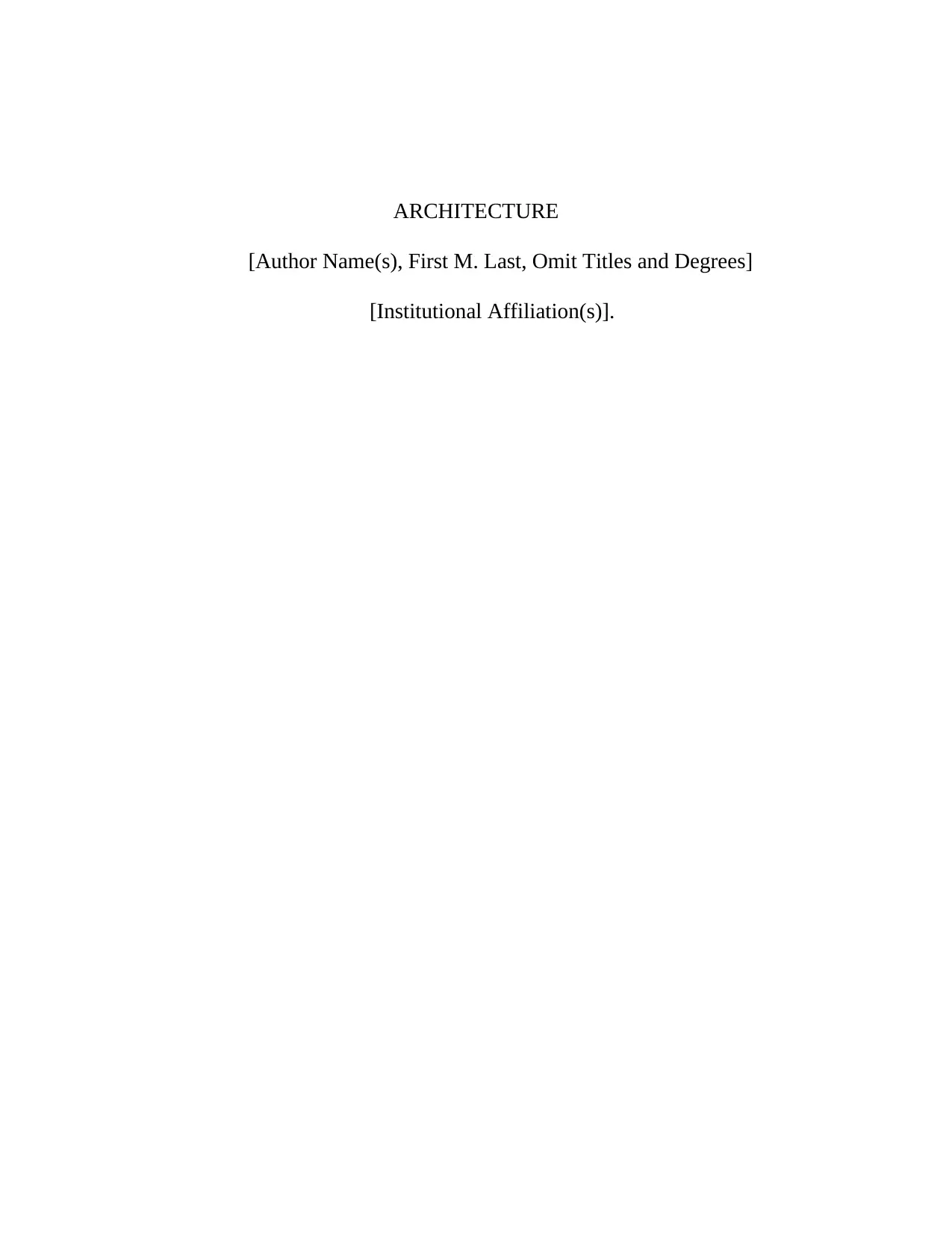
ARCHITECTURE
[Author Name(s), First M. Last, Omit Titles and Degrees]
[Institutional Affiliation(s)].
[Author Name(s), First M. Last, Omit Titles and Degrees]
[Institutional Affiliation(s)].
Paraphrase This Document
Need a fresh take? Get an instant paraphrase of this document with our AI Paraphraser
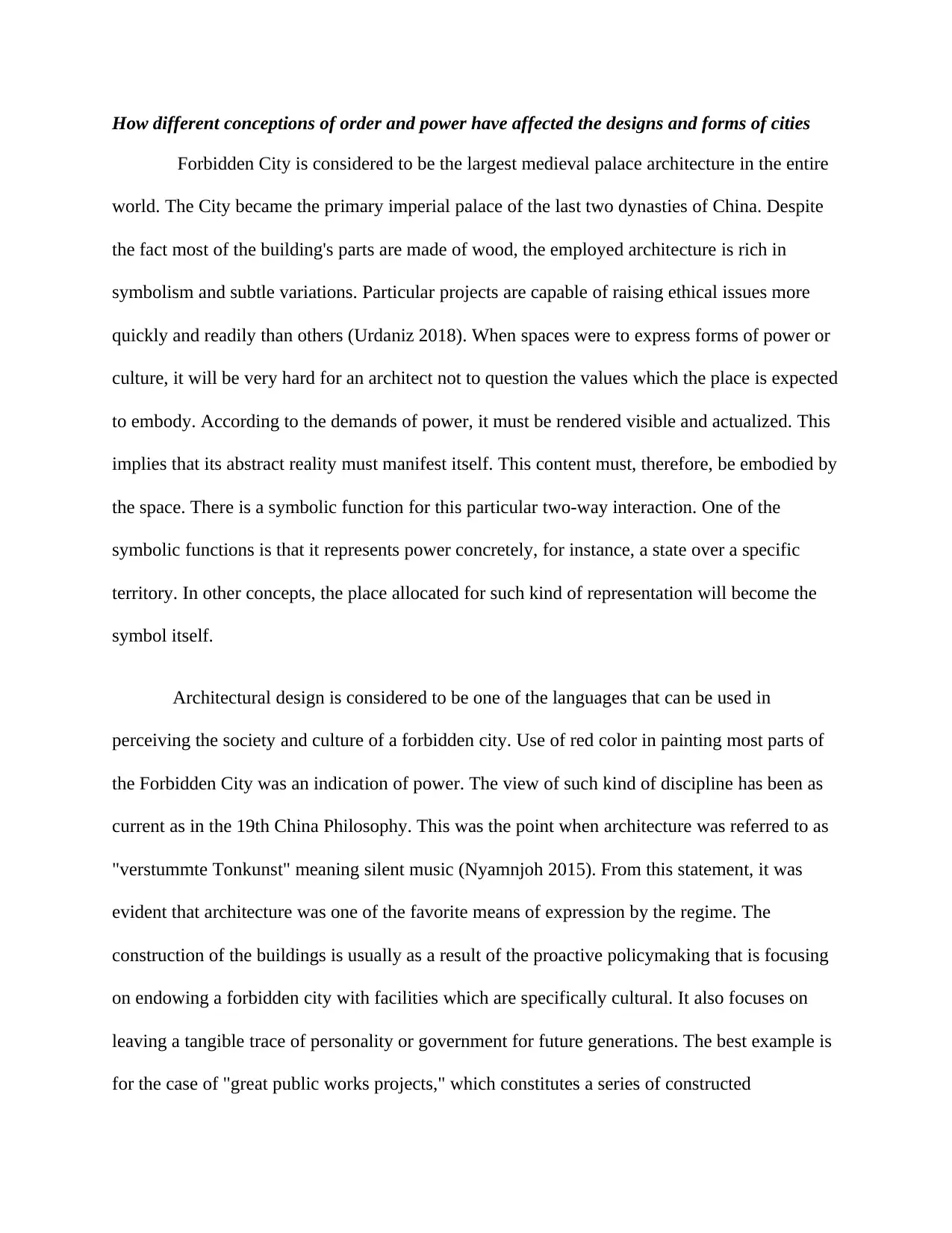
How different conceptions of order and power have affected the designs and forms of cities
Forbidden City is considered to be the largest medieval palace architecture in the entire
world. The City became the primary imperial palace of the last two dynasties of China. Despite
the fact most of the building's parts are made of wood, the employed architecture is rich in
symbolism and subtle variations. Particular projects are capable of raising ethical issues more
quickly and readily than others (Urdaniz 2018). When spaces were to express forms of power or
culture, it will be very hard for an architect not to question the values which the place is expected
to embody. According to the demands of power, it must be rendered visible and actualized. This
implies that its abstract reality must manifest itself. This content must, therefore, be embodied by
the space. There is a symbolic function for this particular two-way interaction. One of the
symbolic functions is that it represents power concretely, for instance, a state over a specific
territory. In other concepts, the place allocated for such kind of representation will become the
symbol itself.
Architectural design is considered to be one of the languages that can be used in
perceiving the society and culture of a forbidden city. Use of red color in painting most parts of
the Forbidden City was an indication of power. The view of such kind of discipline has been as
current as in the 19th China Philosophy. This was the point when architecture was referred to as
"verstummte Tonkunst" meaning silent music (Nyamnjoh 2015). From this statement, it was
evident that architecture was one of the favorite means of expression by the regime. The
construction of the buildings is usually as a result of the proactive policymaking that is focusing
on endowing a forbidden city with facilities which are specifically cultural. It also focuses on
leaving a tangible trace of personality or government for future generations. The best example is
for the case of "great public works projects," which constitutes a series of constructed
Forbidden City is considered to be the largest medieval palace architecture in the entire
world. The City became the primary imperial palace of the last two dynasties of China. Despite
the fact most of the building's parts are made of wood, the employed architecture is rich in
symbolism and subtle variations. Particular projects are capable of raising ethical issues more
quickly and readily than others (Urdaniz 2018). When spaces were to express forms of power or
culture, it will be very hard for an architect not to question the values which the place is expected
to embody. According to the demands of power, it must be rendered visible and actualized. This
implies that its abstract reality must manifest itself. This content must, therefore, be embodied by
the space. There is a symbolic function for this particular two-way interaction. One of the
symbolic functions is that it represents power concretely, for instance, a state over a specific
territory. In other concepts, the place allocated for such kind of representation will become the
symbol itself.
Architectural design is considered to be one of the languages that can be used in
perceiving the society and culture of a forbidden city. Use of red color in painting most parts of
the Forbidden City was an indication of power. The view of such kind of discipline has been as
current as in the 19th China Philosophy. This was the point when architecture was referred to as
"verstummte Tonkunst" meaning silent music (Nyamnjoh 2015). From this statement, it was
evident that architecture was one of the favorite means of expression by the regime. The
construction of the buildings is usually as a result of the proactive policymaking that is focusing
on endowing a forbidden city with facilities which are specifically cultural. It also focuses on
leaving a tangible trace of personality or government for future generations. The best example is
for the case of "great public works projects," which constitutes a series of constructed
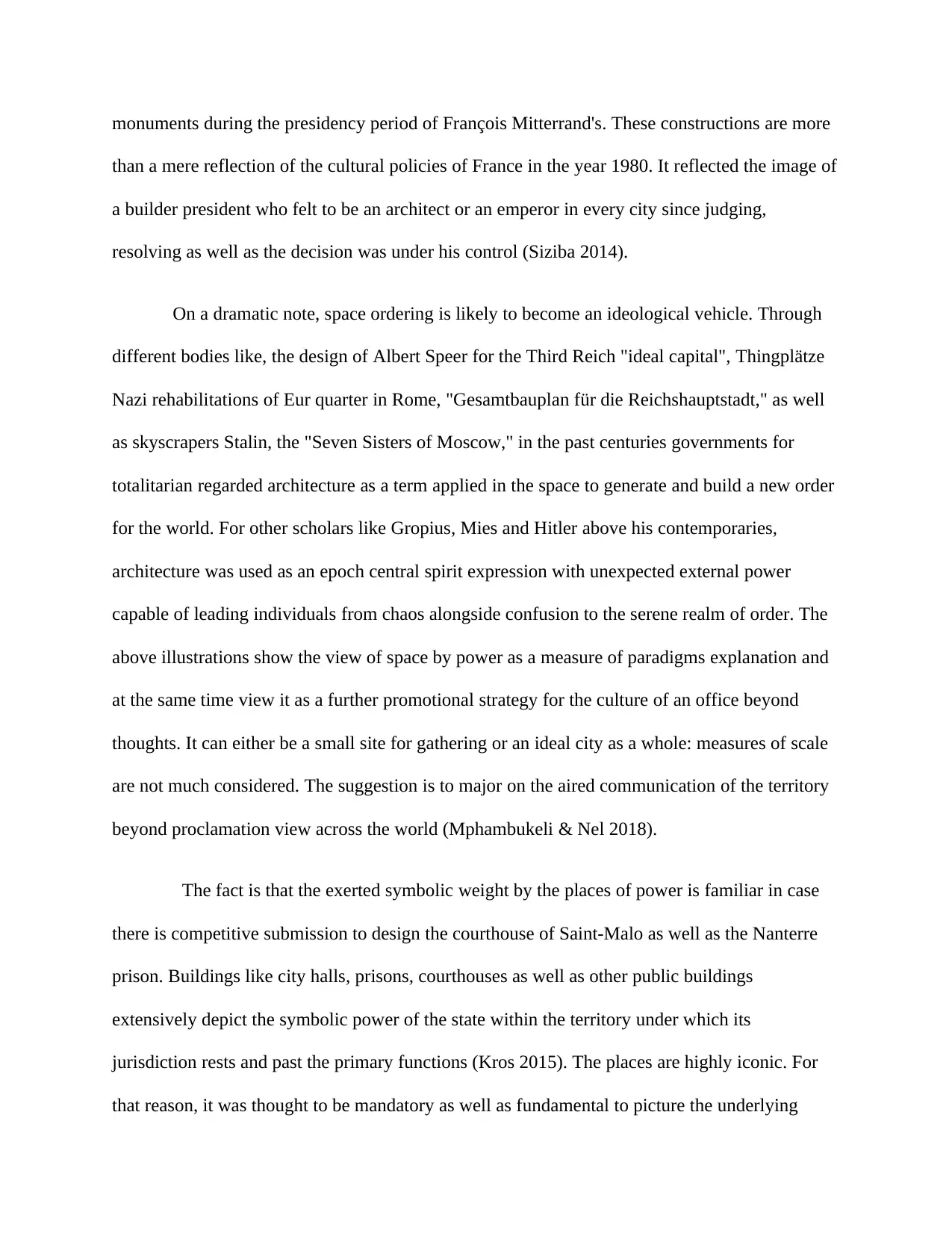
monuments during the presidency period of François Mitterrand's. These constructions are more
than a mere reflection of the cultural policies of France in the year 1980. It reflected the image of
a builder president who felt to be an architect or an emperor in every city since judging,
resolving as well as the decision was under his control (Siziba 2014).
On a dramatic note, space ordering is likely to become an ideological vehicle. Through
different bodies like, the design of Albert Speer for the Third Reich "ideal capital", Thingplätze
Nazi rehabilitations of Eur quarter in Rome, "Gesamtbauplan für die Reichshauptstadt," as well
as skyscrapers Stalin, the "Seven Sisters of Moscow," in the past centuries governments for
totalitarian regarded architecture as a term applied in the space to generate and build a new order
for the world. For other scholars like Gropius, Mies and Hitler above his contemporaries,
architecture was used as an epoch central spirit expression with unexpected external power
capable of leading individuals from chaos alongside confusion to the serene realm of order. The
above illustrations show the view of space by power as a measure of paradigms explanation and
at the same time view it as a further promotional strategy for the culture of an office beyond
thoughts. It can either be a small site for gathering or an ideal city as a whole: measures of scale
are not much considered. The suggestion is to major on the aired communication of the territory
beyond proclamation view across the world (Mphambukeli & Nel 2018).
The fact is that the exerted symbolic weight by the places of power is familiar in case
there is competitive submission to design the courthouse of Saint-Malo as well as the Nanterre
prison. Buildings like city halls, prisons, courthouses as well as other public buildings
extensively depict the symbolic power of the state within the territory under which its
jurisdiction rests and past the primary functions (Kros 2015). The places are highly iconic. For
that reason, it was thought to be mandatory as well as fundamental to picture the underlying
than a mere reflection of the cultural policies of France in the year 1980. It reflected the image of
a builder president who felt to be an architect or an emperor in every city since judging,
resolving as well as the decision was under his control (Siziba 2014).
On a dramatic note, space ordering is likely to become an ideological vehicle. Through
different bodies like, the design of Albert Speer for the Third Reich "ideal capital", Thingplätze
Nazi rehabilitations of Eur quarter in Rome, "Gesamtbauplan für die Reichshauptstadt," as well
as skyscrapers Stalin, the "Seven Sisters of Moscow," in the past centuries governments for
totalitarian regarded architecture as a term applied in the space to generate and build a new order
for the world. For other scholars like Gropius, Mies and Hitler above his contemporaries,
architecture was used as an epoch central spirit expression with unexpected external power
capable of leading individuals from chaos alongside confusion to the serene realm of order. The
above illustrations show the view of space by power as a measure of paradigms explanation and
at the same time view it as a further promotional strategy for the culture of an office beyond
thoughts. It can either be a small site for gathering or an ideal city as a whole: measures of scale
are not much considered. The suggestion is to major on the aired communication of the territory
beyond proclamation view across the world (Mphambukeli & Nel 2018).
The fact is that the exerted symbolic weight by the places of power is familiar in case
there is competitive submission to design the courthouse of Saint-Malo as well as the Nanterre
prison. Buildings like city halls, prisons, courthouses as well as other public buildings
extensively depict the symbolic power of the state within the territory under which its
jurisdiction rests and past the primary functions (Kros 2015). The places are highly iconic. For
that reason, it was thought to be mandatory as well as fundamental to picture the underlying
⊘ This is a preview!⊘
Do you want full access?
Subscribe today to unlock all pages.

Trusted by 1+ million students worldwide
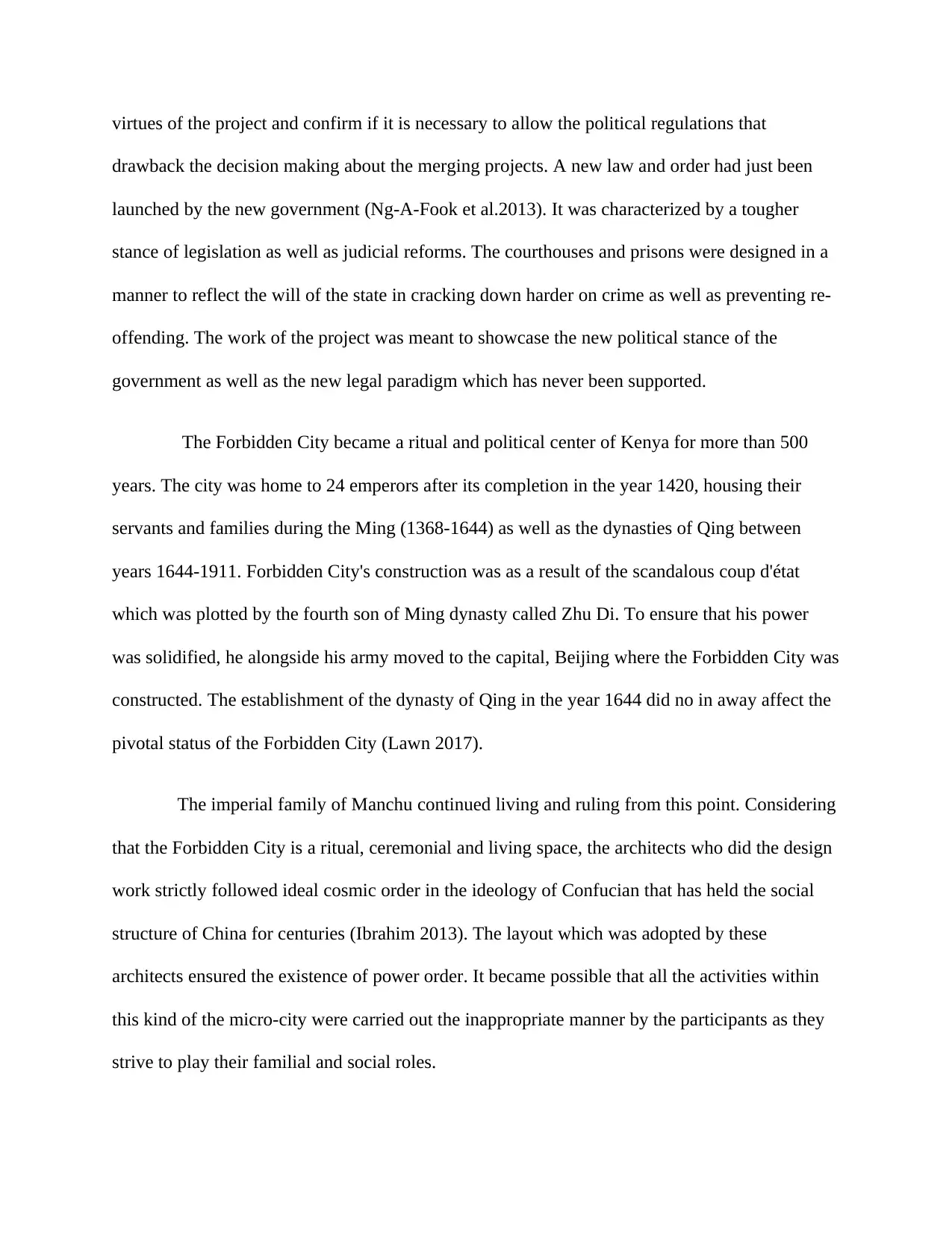
virtues of the project and confirm if it is necessary to allow the political regulations that
drawback the decision making about the merging projects. A new law and order had just been
launched by the new government (Ng-A-Fook et al.2013). It was characterized by a tougher
stance of legislation as well as judicial reforms. The courthouses and prisons were designed in a
manner to reflect the will of the state in cracking down harder on crime as well as preventing re-
offending. The work of the project was meant to showcase the new political stance of the
government as well as the new legal paradigm which has never been supported.
The Forbidden City became a ritual and political center of Kenya for more than 500
years. The city was home to 24 emperors after its completion in the year 1420, housing their
servants and families during the Ming (1368-1644) as well as the dynasties of Qing between
years 1644-1911. Forbidden City's construction was as a result of the scandalous coup d'état
which was plotted by the fourth son of Ming dynasty called Zhu Di. To ensure that his power
was solidified, he alongside his army moved to the capital, Beijing where the Forbidden City was
constructed. The establishment of the dynasty of Qing in the year 1644 did no in away affect the
pivotal status of the Forbidden City (Lawn 2017).
The imperial family of Manchu continued living and ruling from this point. Considering
that the Forbidden City is a ritual, ceremonial and living space, the architects who did the design
work strictly followed ideal cosmic order in the ideology of Confucian that has held the social
structure of China for centuries (Ibrahim 2013). The layout which was adopted by these
architects ensured the existence of power order. It became possible that all the activities within
this kind of the micro-city were carried out the inappropriate manner by the participants as they
strive to play their familial and social roles.
drawback the decision making about the merging projects. A new law and order had just been
launched by the new government (Ng-A-Fook et al.2013). It was characterized by a tougher
stance of legislation as well as judicial reforms. The courthouses and prisons were designed in a
manner to reflect the will of the state in cracking down harder on crime as well as preventing re-
offending. The work of the project was meant to showcase the new political stance of the
government as well as the new legal paradigm which has never been supported.
The Forbidden City became a ritual and political center of Kenya for more than 500
years. The city was home to 24 emperors after its completion in the year 1420, housing their
servants and families during the Ming (1368-1644) as well as the dynasties of Qing between
years 1644-1911. Forbidden City's construction was as a result of the scandalous coup d'état
which was plotted by the fourth son of Ming dynasty called Zhu Di. To ensure that his power
was solidified, he alongside his army moved to the capital, Beijing where the Forbidden City was
constructed. The establishment of the dynasty of Qing in the year 1644 did no in away affect the
pivotal status of the Forbidden City (Lawn 2017).
The imperial family of Manchu continued living and ruling from this point. Considering
that the Forbidden City is a ritual, ceremonial and living space, the architects who did the design
work strictly followed ideal cosmic order in the ideology of Confucian that has held the social
structure of China for centuries (Ibrahim 2013). The layout which was adopted by these
architects ensured the existence of power order. It became possible that all the activities within
this kind of the micro-city were carried out the inappropriate manner by the participants as they
strive to play their familial and social roles.
Paraphrase This Document
Need a fresh take? Get an instant paraphrase of this document with our AI Paraphraser
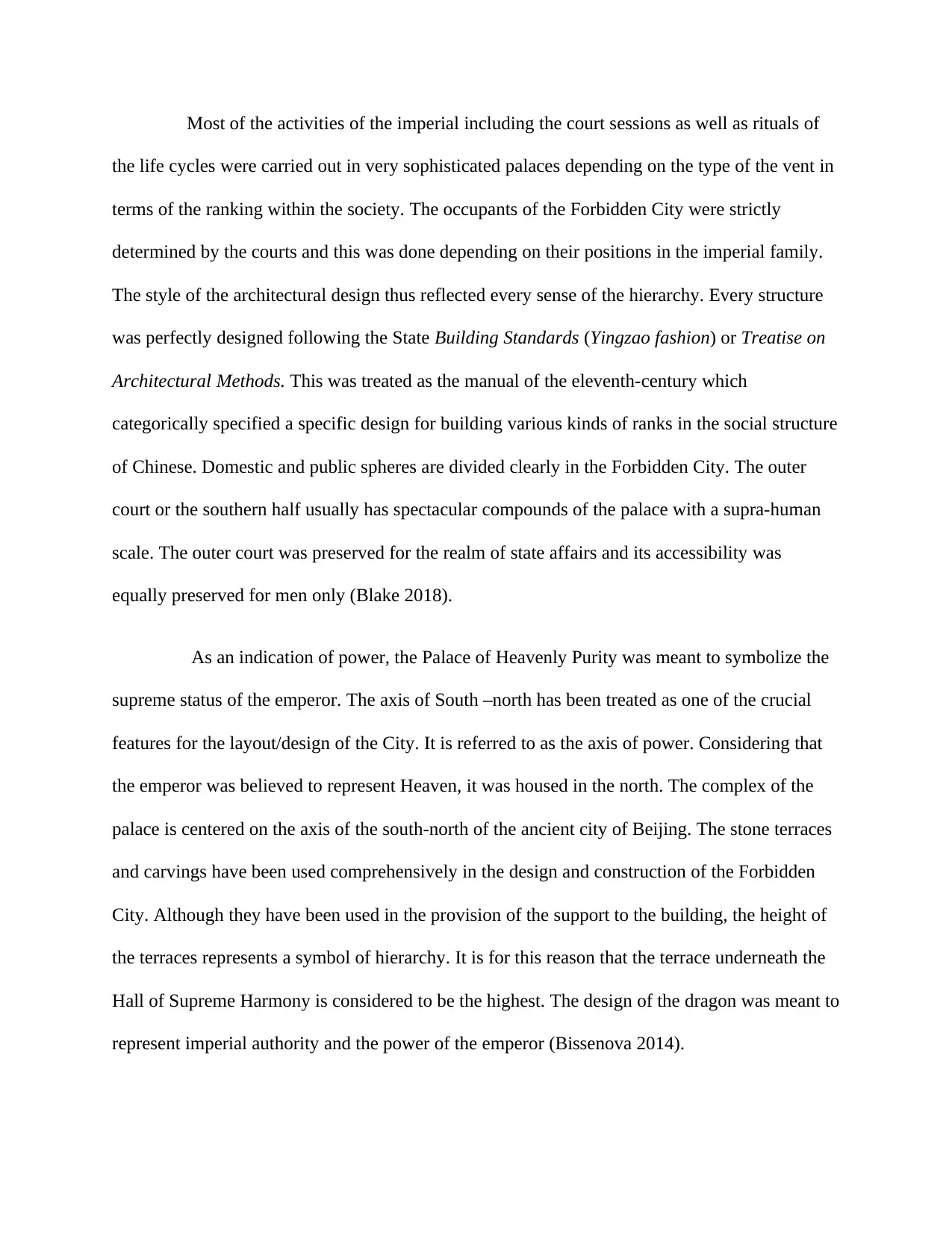
Most of the activities of the imperial including the court sessions as well as rituals of
the life cycles were carried out in very sophisticated palaces depending on the type of the vent in
terms of the ranking within the society. The occupants of the Forbidden City were strictly
determined by the courts and this was done depending on their positions in the imperial family.
The style of the architectural design thus reflected every sense of the hierarchy. Every structure
was perfectly designed following the State Building Standards (Yingzao fashion) or Treatise on
Architectural Methods. This was treated as the manual of the eleventh-century which
categorically specified a specific design for building various kinds of ranks in the social structure
of Chinese. Domestic and public spheres are divided clearly in the Forbidden City. The outer
court or the southern half usually has spectacular compounds of the palace with a supra-human
scale. The outer court was preserved for the realm of state affairs and its accessibility was
equally preserved for men only (Blake 2018).
As an indication of power, the Palace of Heavenly Purity was meant to symbolize the
supreme status of the emperor. The axis of South –north has been treated as one of the crucial
features for the layout/design of the City. It is referred to as the axis of power. Considering that
the emperor was believed to represent Heaven, it was housed in the north. The complex of the
palace is centered on the axis of the south-north of the ancient city of Beijing. The stone terraces
and carvings have been used comprehensively in the design and construction of the Forbidden
City. Although they have been used in the provision of the support to the building, the height of
the terraces represents a symbol of hierarchy. It is for this reason that the terrace underneath the
Hall of Supreme Harmony is considered to be the highest. The design of the dragon was meant to
represent imperial authority and the power of the emperor (Bissenova 2014).
the life cycles were carried out in very sophisticated palaces depending on the type of the vent in
terms of the ranking within the society. The occupants of the Forbidden City were strictly
determined by the courts and this was done depending on their positions in the imperial family.
The style of the architectural design thus reflected every sense of the hierarchy. Every structure
was perfectly designed following the State Building Standards (Yingzao fashion) or Treatise on
Architectural Methods. This was treated as the manual of the eleventh-century which
categorically specified a specific design for building various kinds of ranks in the social structure
of Chinese. Domestic and public spheres are divided clearly in the Forbidden City. The outer
court or the southern half usually has spectacular compounds of the palace with a supra-human
scale. The outer court was preserved for the realm of state affairs and its accessibility was
equally preserved for men only (Blake 2018).
As an indication of power, the Palace of Heavenly Purity was meant to symbolize the
supreme status of the emperor. The axis of South –north has been treated as one of the crucial
features for the layout/design of the City. It is referred to as the axis of power. Considering that
the emperor was believed to represent Heaven, it was housed in the north. The complex of the
palace is centered on the axis of the south-north of the ancient city of Beijing. The stone terraces
and carvings have been used comprehensively in the design and construction of the Forbidden
City. Although they have been used in the provision of the support to the building, the height of
the terraces represents a symbol of hierarchy. It is for this reason that the terrace underneath the
Hall of Supreme Harmony is considered to be the highest. The design of the dragon was meant to
represent imperial authority and the power of the emperor (Bissenova 2014).
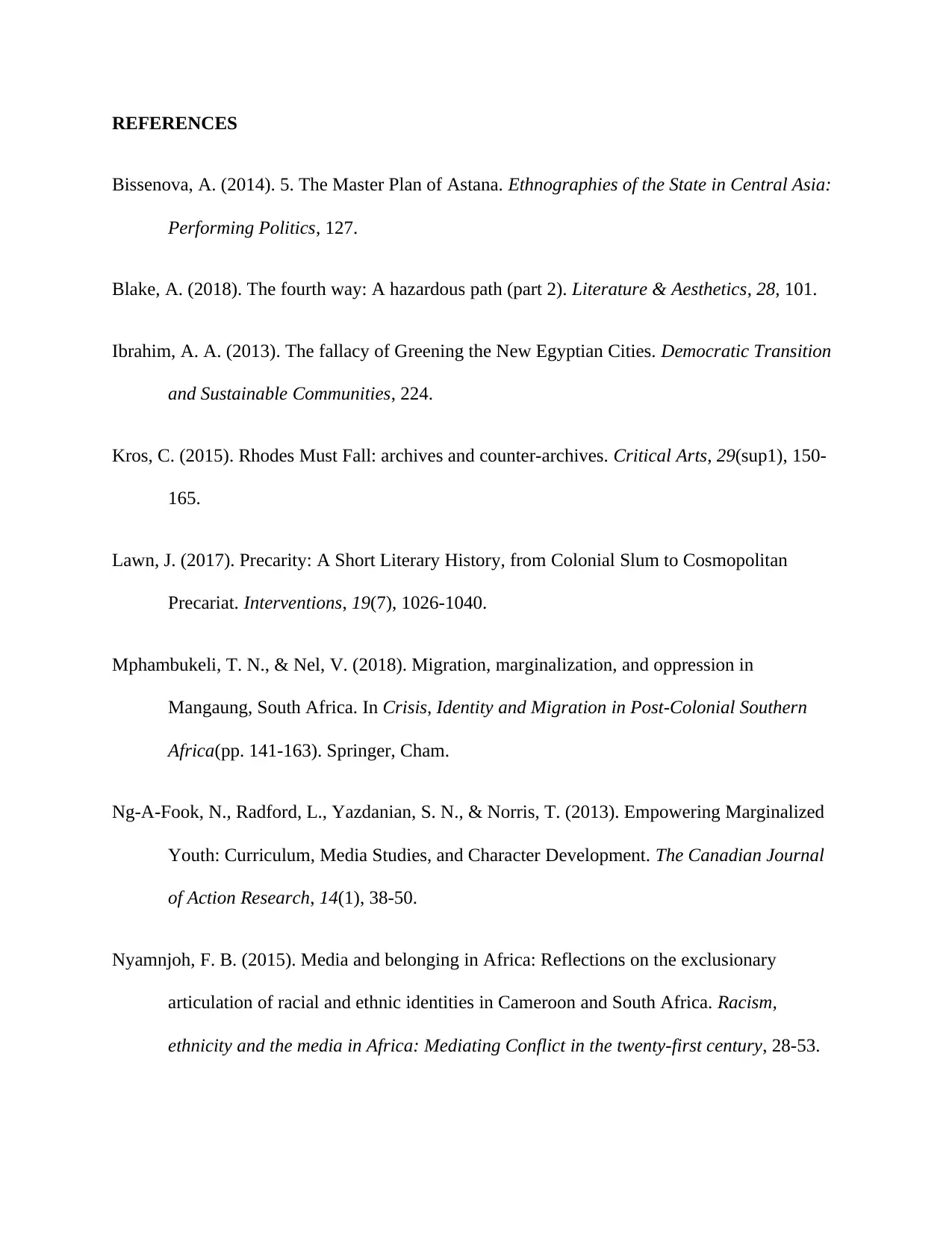
REFERENCES
Bissenova, A. (2014). 5. The Master Plan of Astana. Ethnographies of the State in Central Asia:
Performing Politics, 127.
Blake, A. (2018). The fourth way: A hazardous path (part 2). Literature & Aesthetics, 28, 101.
Ibrahim, A. A. (2013). The fallacy of Greening the New Egyptian Cities. Democratic Transition
and Sustainable Communities, 224.
Kros, C. (2015). Rhodes Must Fall: archives and counter-archives. Critical Arts, 29(sup1), 150-
165.
Lawn, J. (2017). Precarity: A Short Literary History, from Colonial Slum to Cosmopolitan
Precariat. Interventions, 19(7), 1026-1040.
Mphambukeli, T. N., & Nel, V. (2018). Migration, marginalization, and oppression in
Mangaung, South Africa. In Crisis, Identity and Migration in Post-Colonial Southern
Africa(pp. 141-163). Springer, Cham.
Ng-A-Fook, N., Radford, L., Yazdanian, S. N., & Norris, T. (2013). Empowering Marginalized
Youth: Curriculum, Media Studies, and Character Development. The Canadian Journal
of Action Research, 14(1), 38-50.
Nyamnjoh, F. B. (2015). Media and belonging in Africa: Reflections on the exclusionary
articulation of racial and ethnic identities in Cameroon and South Africa. Racism,
ethnicity and the media in Africa: Mediating Conflict in the twenty-first century, 28-53.
Bissenova, A. (2014). 5. The Master Plan of Astana. Ethnographies of the State in Central Asia:
Performing Politics, 127.
Blake, A. (2018). The fourth way: A hazardous path (part 2). Literature & Aesthetics, 28, 101.
Ibrahim, A. A. (2013). The fallacy of Greening the New Egyptian Cities. Democratic Transition
and Sustainable Communities, 224.
Kros, C. (2015). Rhodes Must Fall: archives and counter-archives. Critical Arts, 29(sup1), 150-
165.
Lawn, J. (2017). Precarity: A Short Literary History, from Colonial Slum to Cosmopolitan
Precariat. Interventions, 19(7), 1026-1040.
Mphambukeli, T. N., & Nel, V. (2018). Migration, marginalization, and oppression in
Mangaung, South Africa. In Crisis, Identity and Migration in Post-Colonial Southern
Africa(pp. 141-163). Springer, Cham.
Ng-A-Fook, N., Radford, L., Yazdanian, S. N., & Norris, T. (2013). Empowering Marginalized
Youth: Curriculum, Media Studies, and Character Development. The Canadian Journal
of Action Research, 14(1), 38-50.
Nyamnjoh, F. B. (2015). Media and belonging in Africa: Reflections on the exclusionary
articulation of racial and ethnic identities in Cameroon and South Africa. Racism,
ethnicity and the media in Africa: Mediating Conflict in the twenty-first century, 28-53.
⊘ This is a preview!⊘
Do you want full access?
Subscribe today to unlock all pages.

Trusted by 1+ million students worldwide
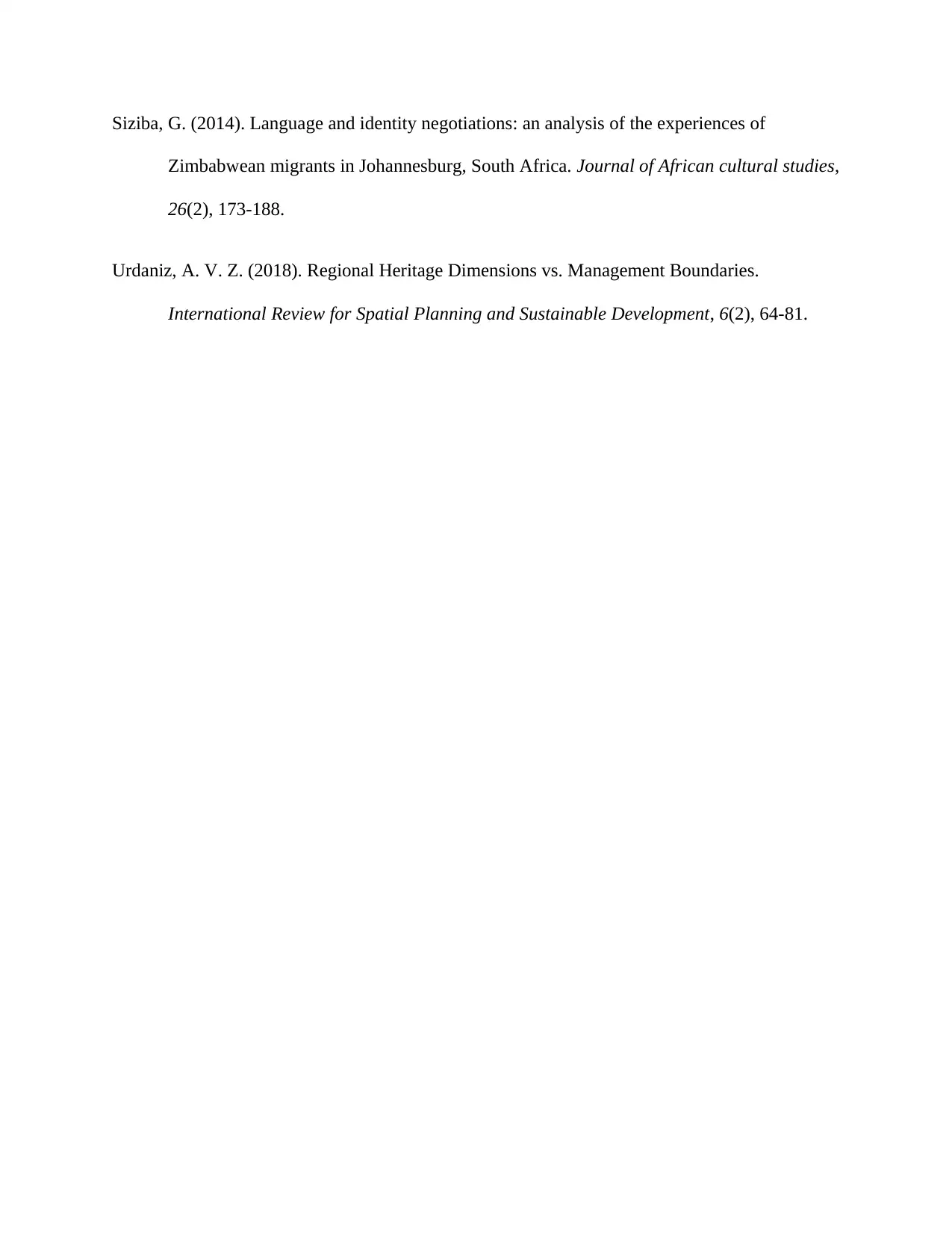
Siziba, G. (2014). Language and identity negotiations: an analysis of the experiences of
Zimbabwean migrants in Johannesburg, South Africa. Journal of African cultural studies,
26(2), 173-188.
Urdaniz, A. V. Z. (2018). Regional Heritage Dimensions vs. Management Boundaries.
International Review for Spatial Planning and Sustainable Development, 6(2), 64-81.
Zimbabwean migrants in Johannesburg, South Africa. Journal of African cultural studies,
26(2), 173-188.
Urdaniz, A. V. Z. (2018). Regional Heritage Dimensions vs. Management Boundaries.
International Review for Spatial Planning and Sustainable Development, 6(2), 64-81.
1 out of 7
Related Documents
Your All-in-One AI-Powered Toolkit for Academic Success.
+13062052269
info@desklib.com
Available 24*7 on WhatsApp / Email
![[object Object]](/_next/static/media/star-bottom.7253800d.svg)
Unlock your academic potential
Copyright © 2020–2025 A2Z Services. All Rights Reserved. Developed and managed by ZUCOL.



